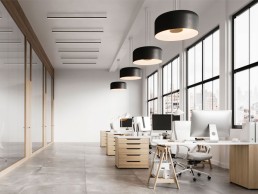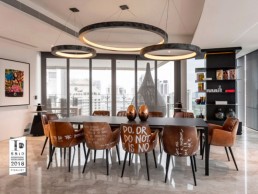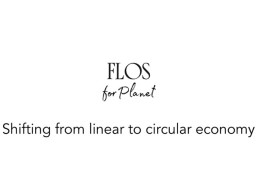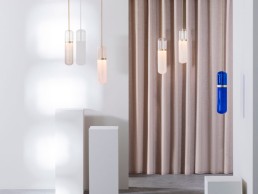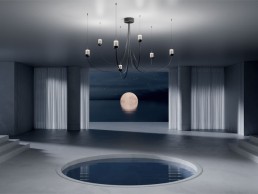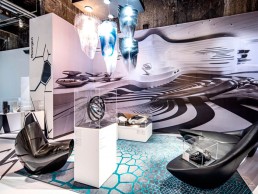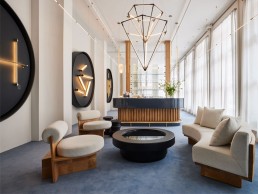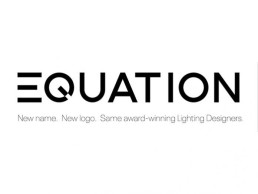Cerno - Torrey and Rincon
Proven old-world manufacturing techniques inspire Cerno’s new line of spun metal LED light fixtures. Twelve years after three childhood friends founded Cerno, its team elected to not pivot over the last year but rather look inward, leaning on its existing strengths as innovators and makers. The company’s new line of architectural products demonstrates a passion and commitment to designing beautiful objects built to last. A standout in its new line is a family of spun metal fixtures featuring the Torrey and Rincon pendants and flush mounts, named after local California beaches.
Speaking with Cerno’s founders, it’s evident that they are energised and know how to enjoy the creative process. “Running a business is a wild journey; there are many opportunities for the challenging parts of entrepreneurship to cannibalise the fun aspects of our work,” explains Bret Englander, Co-founder of Cerno. “We are at our best as designers when we are having fun, which is what is happening right now.”
Driven by performance, the Torrey and Rincon deliver a high quality of light via an indirect source, emitting an even and diffuse light while not neglecting the need for a powerful delivered lumens package. The solid metal shades are sleek, and robust and offered in an array of finishes, all done in-house. The round disc, which houses the LEDs and driver, is where Cerno inserted its signature use of solid hardwood available in walnut and oak; the disc is also available in metal. The scale of these fixtures is impressive and makes a tasteful statement in any environment. The Rincon has a 28-inch diameter and is voluminous with a gaping cavity. The Torrey has a shallower depth and is offered in a 30-inch diameter.
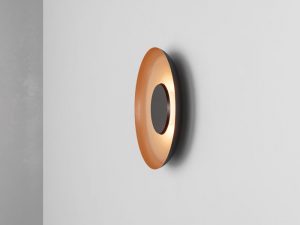
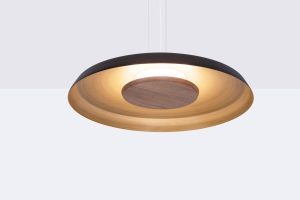
Nick Sheridan, Co-founder, and Director of Design spoke proudly about the latest creations: “The Torrey and Rincon are not about strict minimalism or feeling ultra-modern. The shade mixes subtle curves with hard facets creating a nostalgic form that pays homage to the ubiquitous reflector shade while feeling fresh with a simplified geometry.”
Elaborating on the importance of the quality of the light, he adds: “The way we approached delivering the light was critical; the light engine disc nestled in the centre allows for a beautiful soft gradient of light fading outwards, preventing any chance for glare.”
Reflecting on Cerno’s new products and looking at the breadth of its line, it’s clear that the people behind the products are willing to explore outside of their comfort zone. The line is cohesive yet unpredictable. Rigid modernism bleeds into more whimsical forms. “Nick is a student of modernism and architecture, but he’s also an artist,” explains Englander. “These different sources of inspiration inform our aesthetic.”
Manufacturers were forced to evaluate every aspect of their business over the past year. Unforeseen obstacles popped up each week. The fragility of the supply chain required all companies to be nimble and resourceful. Cerno’s is a vertical manufacturer, with raw materials coming in and finished products going out, which places it in a better position than most to navigate the pandemic.
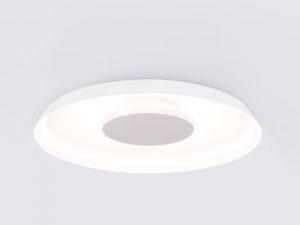
Co-founder and Director of Engineering Daniel Wacholder spoke about the last year with an optimistic and humble tone: “The cracks exposed in the entire manufacturing ecosystem gave us the confidence to double down on our long-time commitment to manufacturing nearly everything in-house,” says Wacholder. “It also caused us to look very closely at the reliability and integrity of the companies that we choose to purchase materials from.”
Cerno’s new line of spun products is a reflection of this thinking. The pendants are made from a small number of raw materials processed in-house in a just-in-time fashion. Wacholder elaborates on their approach: “The Torrey and Rincon are a result of a philosophy that is the exact opposite of the typical manufacturing thinking of the last 50 years, which emphasised large batches, outsourcing, and taking advantage of cheap offshore labour.”
The founders’ passion and excitement for design continue to burn bright, and the lifelong friends share a deep appreciation and respect for their team and their customers. “Daniel, Nick, and I had a dream, fueled by believing in one another and our passion for design and building things, but none of this is possible without our inspiring team and our inspiring customers,” concludes Englander.
Asian design studio Elliot James Interiors, launches in the UK
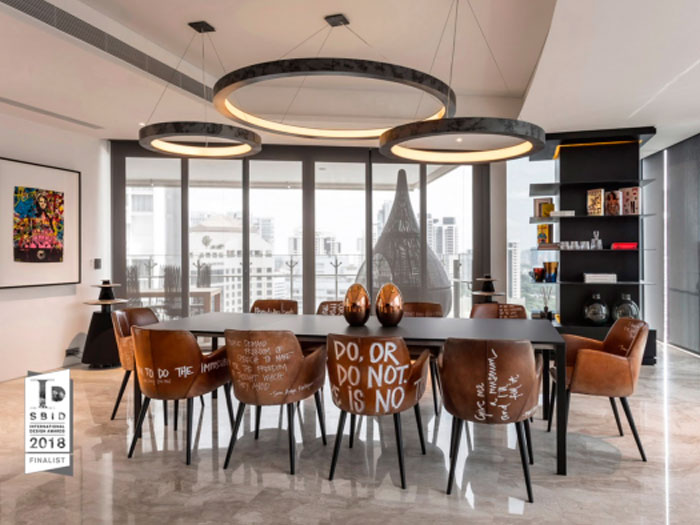
(UK) - Award-winning Asian design studio Elliot James Interiors, launches in the UK.
Elliot James Interiors is a British owned multi award-winning luxury interior design studio, which was established in Singapore, and has recently opened its doors in the UK. It is one of the leading ateliers for modern luxury interior design in Asia, and is excited to bring its unique approach, which elegantly fuses British and Asian style to England.
Founded in Singapore in 2012 by British born and bred designer, Elliot Barratt; Elliot James Interiors has amassed a team of experienced internationally trained architects and designers who specialise in luxury residential and commercial design and renovation. With a key focus on quality, detail, opulence and authenticity, Elliot James Interiors prides itself on constantly evolving the company to offer clients the best designs, services and opportunities. Based in both Europe and Asia also enables Elliot James Interiors to offer clients on the ground, experienced designers, who can provide their unique global design and project management experience.
Elliot James Interiors has won a multitude of awards across the past ten years, including ‘The Best Luxury Architect and Interior Design Studio Singapore’ at the Luxury Lifestyle Awards 2020 and Winner of the ‘Residential House Under £1m Design’ at the SBID International Design Awards 2018.
“The key to an elegant, opulent, bespoke design is understanding the aspirations of the client, the relevance of location and thoroughly maximising the potential of existing elements of the space,” says Elliot Barratt, Founder and CEO, Elliot James Interiors.
Flos announces carbon neutrality
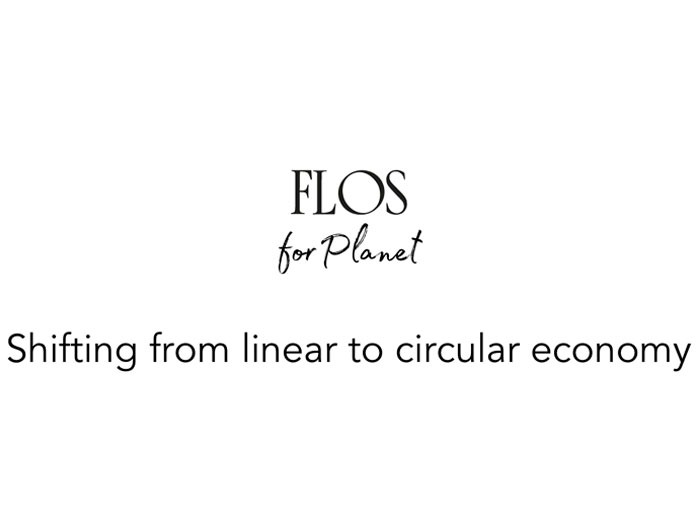
(Italy) - Flos Group announces it reaches carbon neutrality in 2020.
Flos Group announced that in 2020 the company has reached the carbon neutrality, as a relevant step of the process towards the carbon negativity/climate positivity level.
Carbon neutrality entails balancing the company CO2 emissions with offsetting obtained by purchasing the corresponding amount of carbon credits. The ones Flos has chosen are generated by nature-based projects with a positive impact on high environmental interest areas.
Specifically, these credits come from the activities of the Great Bear Forest Carbon Project in Canadian British Columbia and from the Guatemalan Conservation Coast Project. Both projects aim to save the native forests and the rich wildlife (including Grizzly bears) as well as to help the local population managing them properly.
In parallel, Flos has already activated a series of projects aimed at working on the continuous reduction of emissions and the circular economy, which we will soon describe in the next newsletters.
Decorex adds new content to The Edit
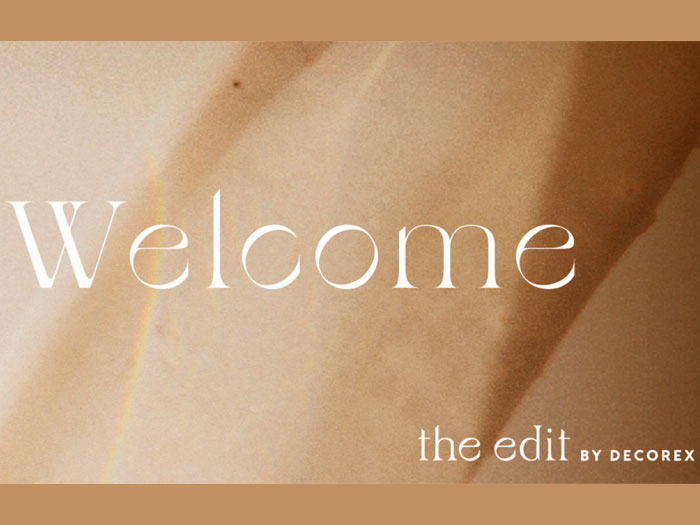
New brand Empty State launches
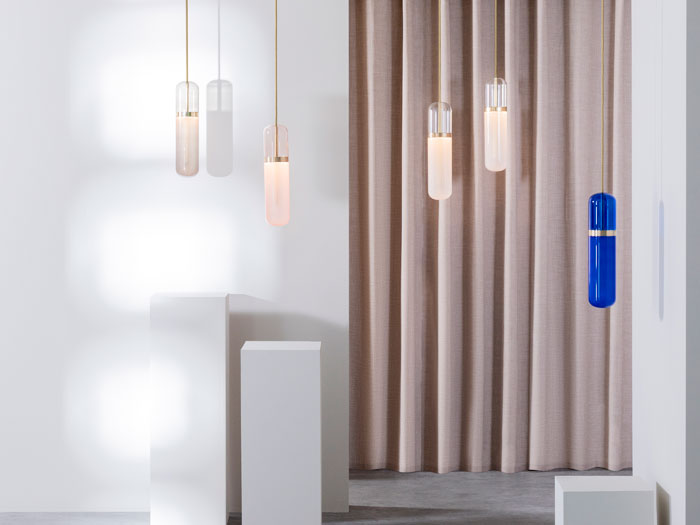
(UK) - British lighting manufacturer Cameron Design House launches sister brand, Empty State.
Brought to you by the creative duo behind award-wining Cameron Design House - the brand renowned for pushing the boundaries of British bespoke lighting sculptures across the globe - Empty State delivers customisable made-to-order lighting products for the wider market.
Empty State combines a wealth of knowledge from the lighting sector with over three decades of experience. Creating custom lighting solutions for projects around the world Empty State delivers modular lighting with an architectural flair, timelessly designed to last a lifetime.
“We’ve been working on Empty State for a while with our team of architects, engineers and designers, and are very excited to be launching our new brand this summer. A sister company to Cameron Design House, Empty State embodies our architectural vision, delivering abstract shaped lighting, which can be configured to suit any project around the globe,” says Ian Cameron, Founder and Creative Director, Cameron Design House and Empty State.
Products are formed from solid materials and made in-house by hand in the UK. The collection is made up of six highly engineered products including the Pill – a capsule pendant made from hand-blown glass, and the Branch – a frosted cylindrical tiered brass structure. With structures following the themes of modularity, whilst drawing inspiration from contemporary architectural styles and design icons through the ages, the products are suitable for a vast array of projects including residential, commercial and hospitality spaces.
With each product made to the finest detail with the highest precision, each design is available in a curated collection of states with customisable elements providing endless possibilities.
Empty State will be unveiling their designs for the first time at this year’s inaugural Design London show, during London Design Festival 2021.
Alexandria Dauley & Sophie Ashby
darc magazine – along with sister publication arc – has uncomfortably recognised the lack of representation of ethnic minorities across the lighting and design communities. It wasn’t until a horrific act of violence towards George Floyd in the USA, which triggered international media coverage in 2020, that we looked inwards at our reporting of the lighting world. As a result, we are now working to better this and ourselves as impartial journalists to ensure we are covering the full breadth of the industry, bring recognition to those that deserve it and support making the design industry an equal one.
To begin our journey in ensuring more of an ethnically and culturally balanced representation of our community, in our recent edition of darc designers in 3d, we brought you a collection of profiles that celebrate some of the top international professionals in lighting from various backgrounds. This is by no means an extensive depiction of the ethnic minority community in design, but merely a snapshot and starting point to further promote its members and their important work.
To start us off, darc caught up with founders of United in Design, Alexandria Dauley and Sophie Ashby, who explain a little more about their initiative, which aims to support those entering the interior design industry.
Can you give us a little background about yourselves and your careers? How do you know each other?
Sophie: As is the case with so many interior designers, I moved a lot growing up. With a South African mother and a British father, my childhood was spent living for stints in London, Stellenbosch (South Africa) and Devon and, with 14 or so moves, I got used to unpacking and rearranging my bedroom. I’ve always been fascinated by the idea of home and how much it can mean to people. I was very lucky to get an apprenticeship with Victoria Fairfax, where I worked on some very special projects. Studio Ashby was born as soon as I got my first private client. I was lucky that within a couple of weeks, one client quickly became three and things have continued to grow steadily from there.
Alex: My love of interior design started when aged 19 I moved to London from Wales and I began working in the property industry as a relocation agent and property finder. I was fascinated by the wide ranging property styles, architecture and how interiors influenced the way you live and feel within your home. Having renovated my own homes and once my daughters were a little older I decided to follow my passion, studying at KLC School of Design in London and then setting up my practice, Dauley Design. My mentor Evey Dunbavin-Hands has guided me over the years and I now work on wonderful residential projects in Surrey and South London for great clients. I am passionate about creating well-designed homes for my clients and feel incredibly lucky to be able to have a career that I love, which allows me to indulge my creativity
Sophie: Alex and I discovered quite quickly that we were simultaneously having the same conversations, thoughts, ideas and were independently beginning to put the edges to some kind of initiative. We spoke on Zoom a few times, got on instantly and agreed that one strong message was better than many quieter ones so we joined forces!
What are your experiences with diversity, or the lack of, within interior design?
Sophie: On 4 June 2020 I issued a statement on the Studio Ashby Instagram in response to the murder of George Floyd and the global anti-racism movement, acknowledging the studio’s shortcomings in running a diverse company and also some uncomfortable home truths about the elitist and exclusionary nature of the design world. The response I received was overwhelming; I spoke to at least 20 people on Zoom over the course of the following week, mainly black designers and students who had a story to tell me. I heard some very real and desperately sad stories and received the most extraordinarily heartfelt and open responses to my post that I felt motivated and compelled to figure out how I could help.
Alex: As a black interior designer I am very aware that the industry is not diverse. There are many stories of designers from ethnic minority backgrounds having negative experiences trying to access the industry and that needed to change. My passion for United in Design was ultimately fuelled by first-hand experience of this reality - which is why having trained and tutored at KLC School of Design I began to reach out to leading industry figures to specifically promote the benefits of addressing the inequality.
What triggered the formation of United in Design?
Sophie: On #blackouttuesday, in light of the murder of George Floyd and the #BLM protests, I, like millions of others put up a black square on our @studioashby Instagram feed. I took the implied intention of that day very seriously and vowed to myself to do much more than just post the square; I took the day off work and tried to give the complexities of the problem thought whilst also considering my position in all of this. I put out a statement a few days later acknowledging my failures with regards to running a diverse company and acknowledged some glaring issues within my industry.
Alex: I was inspired by my own positive personal experiences of outreach programmes and mentoring and I knew that incorporating those initiatives, amongst others in the industry could make a difference. The name signifies what we would like to see happen in the world, not just in Interior Design...Unity. People of all races, colours, creeds and genders all need to come together and work together to create unity.
Can you describe the initiative’s concept?
Alex: To face the inequality head-on and provide actionable avenues for change. We hope to play a part in making interior design an accessible and obtainable career choice, by working with the industry to tackle the obstacles preventing this - correcting the balance and levelling the playing field.
How did you get the initiative off the ground and circulated within the industry?
Sophie: Time, love, commitment, a drive for change and an excellent steering committee and teams of trustees and councillors!
What was the aim you were striving to achieve with the programme? Why is it so important?
Alex: We aim to become an ongoing sponsored initiative that can nurture, coach and develop high potential candidates from diverse backgrounds, eventually funding scholarships, apprenticeships and bursaries for programme participants via annual subscription fees and events.
Who is involved in the running of United in Design?
Sophie: We’ve worked pretty tirelessly to get it up and running in a tight timeframe and of course the context of a global pandemic too. We’re really fortunate to have such a dynamic, informed, and perceptive team of trustees and councillors that we can lean on. Admittedly, it’s been a challenge - but a hugely rewarding one, and one we are so proud of! Alex and I work well together - she is a ‘doer’, as am I, and we both seem to be solutions-driven, fast-moving people so the combination of us together works.
Who is currently taking part in the programme? Which brands / studios signed up? Are you trying to approach more?
Alex: By pooling groups of four design studios, makers and suppliers together we are able to provide a 12-month apprenticeship placement with the apprentice spending three months in each organisation. The apprentices are paid a junior designer salary, split across the four studios, giving each the scope to gather a broader set of skills, knowledge and contacts in order to progress through the industry.
Our first pool of apprentices are already in action, gaining experience over the year with companies such as Laura Hammett Interiors, Turner Pocock and Brady Williams Studio and many other leading firms.
What feedback have you received from the participants?
Sophie: Overwhelmingly positive, inspiring and hopeful for change.
Alex: Sophie and I have been so thrilled with the response so far and we have now had more than 120 partners signed up for the initiative. We are also starting to receive emails from applicants who wish to receive mentoring, work experience and apprenticeship placements and many new outreach projects are being set up in partnership with United in Design.
Are you working on expanding the programme for longevity?
Sophie: We know that fundraising will become quite a big part of what United in Design is about; we want to make it easier for those given work experience, internship or apprenticeship opportunities by helping them on their journey with financial support for travel and accommodation. This year we piloted our United in Design Apprenticeship scheme and hope that this becomes a long-term initiative, run by businesses and individuals that have a significant impact in providing a foot in the door for those who need a pathway into our world. We also dream of setting up a United in Design scholarship fund. We will also be hosting our first festival - date soon to be confirmed.
Are you aware of anything else happening in the industry that addresses diversity issues?
Alex: There are some brilliant initiatives like Design Can, which are helping to provide actionable change. It feels like there is real momentum from across the industry.
What can the industry do to help?
Alex: If you are an interior designer, maker, supplier, magazine, stylist, photographer, interior architect or anyone working in this sector looking to take actionable steps toward equity and inclusion - please visit our website to register your interest. We would love to have you as part of the conversation.
Moooi - Gravity
Dutch brand Moooi in June unveiled the Gravity Chandelier, a re-imagination of the chandeliers of the past designed by British designer Paul Cocksedge.
The Gravity Chandelier replaces rigidity to elasticity, with flexible arms to customise the chandelier’s diameter and choose where and how the light travels. The Gravity Chandelier is available worldwide from 29 June online and in the Moooi Brand Stores in Amsterdam, London, Stockholm, and New York. To celebrate the launch, Moooi is also premiering Defy Gravity – a brand-new digital brand experience on Moooi.com.
The Gravity Chandelier is the definition of a modern chandelier. At a first glance, it doesn’t reveal its flexibility and cleverness; it takes a second look to unravel its mystery. Free-flowing arcs are dynamic instead of static, thanks to elegant wiring holding up ornamented glass cups. This creates endless possibilities in compositions, making the Gravity Chandelier suitable for any space.
As the name suggests, Gravity plays a main role in the design of the chandelier. The suspended elements with their natural curves shape the chandelier and create forms that are reminiscent of precise lines of ink, drawn by pen or brush on a piece of paper. Gravity causes the graceful arcs of the strands to hang in mid-air, ending in a pressed glass filled with sparkling lights.
Moooi and designer Cocksedge underwent extensive research to find the perfect material. A vast range of fabrics and cords were tested, and the final choice fell to an engineered flat power cable with braided exterior detailing, which can create elegant and flowing arcs. The pressed glass cups at the end of each arm are an elegant and functional part of the Gravity Chandelier. The pressed glass creates a magnified sparkling effect. Elegant wiring, fixed onto the glass cups, upholds the Gravity Chandelier’s flexible arms.
The Gravity Chandelier is available in two sizes - 5 and 7 arm – and in a choice of frosted or clear pressed glass cups.
Talking about the design, Paul Cocksedge says: "The Gravity Chandelier was about me looking at something that’s made as a rigid, solid, and static object. And then imagining it as something that’s very light and flexible."
On the collaboration, Robin Bevers, CEO of Moooi, comments: "Moooi and Paul Cocksedge go way back. Besides that, we love him as a friend, we are thrilled to be working with such an inventive and interdisciplinary designer as Paul. Both our vision of what is extraordinary and what resides on the edge of art and functionality is very much alike. This made for a very smooth and natural collaboration. His Gravity Chandelier is testament to that and we can’t wait to show this piece to the world."
Slamp in shanghai to celebrate Zaha Hadid

(Shanghai) - Slamp celebrate Zaha Hadid Studio’s 40th Anniversary.
July was the official opening of the “ZHA Close Up: Work & Research” public exhibition in Shanghai’s MAM (museum of modern art), presenting the studio’s vast portfolio divided into categories including computation and design, social interaction, analytics and insights, and virtual reality. The exhibition is open until August 29, 2021.
The ZHD co-director Wood Yao comments that, “When designing the ZHD exhibition space our intention was to provide a context for visitors that facilitates multi-layered engagement with the objects, and the history of the brand. We are also delighted to be launching, within this space, new products in collaboration with some of our most valued clients in China, which will further strengthen our links to the region. We feel honoured to share and celebrate 40 years of Zaha Hadid, and for the first time an exhibition will display a timeline of the studio, using key projects, demonstrating her legacy and continued relevance today.”
There is an exhibition within the exhibition on the third floor, where unreleased projects and pieces from long-standing collaborations are on display. Slamp’s iconic Avia and Aria suspensions are amongst greats like Bulgari, Lalique, and Rosenthal.
Juniper joins ranks on Inc. magazine's top 5000 companies list.

(USA) - Juniper ranks no. 2497 on 2021 Inc. 5000, with three-year revenue growth of 168 percent.
Inc. magazine recently revealed that Juniper is No. 2497 on its annual Inc. 5000 list, one of the most prestigious rankings of the USA's fastest-growing private companies. The list represents a unique look at the most successful companies within the American economy’s most dynamic segment - its independent small businesses. Intuit, Zappos, Under Armour, Microsoft, Patagonia, and many other well-known names gained their first national exposure as honourees on the Inc. 5000.
“We’re so proud to be in the top 50% of America’s 5000 fastest growing companies. It’s especially notable for our 10th anniversary, as this honour validates the hard work of the past ten years,” states Shant Madjarian, President of Juniper.
“The 2021 Inc. 5000 list feels like one of the most important rosters of companies ever compiled,” says Scott Omelianuk, editor-in-chief of Inc. “Building one of the fastest-growing companies in America in any year is a remarkable achievement. Building one in the crisis we’ve lived through is just plain amazing. This kind of accomplishment comes with hard work, smart pivots, great leadership, and the help of a whole lot of people.”
Not only have the companies on the 2021 Inc. 5000 been very competitive within their markets, but this year’s list also proved especially resilient and flexible given 2020’s unprecedented challenges. Among the 5,000, the average median three-year growth rate soared to 543 percent, and median revenue reached $11.1 million. Together, those companies added more than 610,000 jobs over the past three years.
Complete results of the Inc. 5000, including company profiles and an interactive database that can be sorted by industry, region, and other criteria, can be found at www.inc.com/inc5000.
How Very Queer: LGBTQ+ Identities in the Lighting Industry
Presented in partnership with Women in Lighting, the North American Coalition of Lighting Industry Queers (NACLIQ) and Women in lighting + Design (WILD), this panel discussion acknowledges the role and experience of Queer/LGBTQ+ identities within the lighting industry, and aims to make sure that we are inclusive of all women and gender non-conforming individuals within the lighting community.
Panelists shared from their experience, and provided a history of the queer perspective, current struggles, and definitions for any who are curious to better understand their friends and colleagues under the LGBTQ+ umbrella and to open pathways of communication across the global lighting community.
Panelists: Francesca Bastianini, WIL USA Ambassador / Principal, Sighte Studio Alana Shepherd, NACLIQ / Principal, Intangible Light Sophie O'Rourke, Nulty Lighting Marién Vélez, WIL Puerto Rico/Caribbean Ambassador / 22 Studio
Resources discussed in the panel can be found here.
www.womeninlightingdesign.wordpress.com
GIA Equation rebrands as Equation
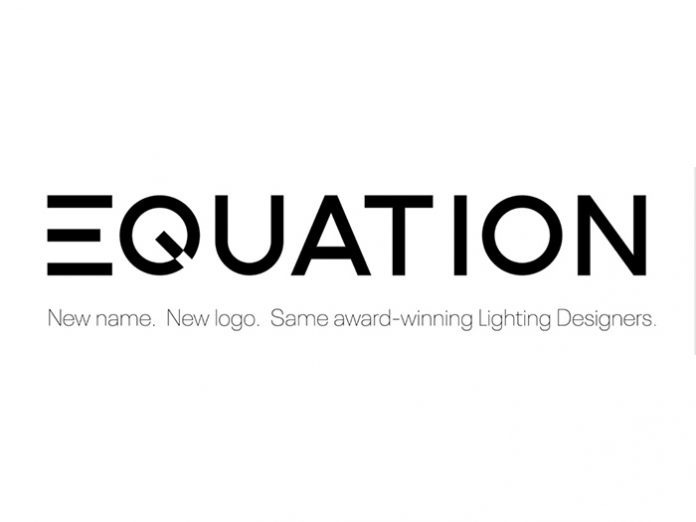
(UK) – Lighting design practice GIA Equation has undergone a full rebrand, changing its name to Equation.
The new name aims to reflect the fact that the studio is an independently run company from GIA, and has been for a number of years. Financially and operationally, it is unchanged and will continue to be a powerful brand, dedicated to delivering design excellence with a client-focused service.
The rebranded Equation has also launched a new website, which showcases the firm’s UK and international portfolio, covering almost every built environment sector, including commercial, residential, retail, hospitality, urban regeneration and masterplanning.
Maida Hot, Equation Managing Director, said: “From a single statement interior feature to an extensive exterior lighting scheme for a large development site, we give each project the same level of care and attention, starting from first principles, to produce designs that have maximum impact. Our thought process is firmly focused on what drives our client – it makes every project an exciting journey.”
Recolight analysis shows high recycling rate in luminaires

(UK) – Recolight has commissioned a detailed analysis to assess the recyclability if waste luminaires. The results show that more than 83% of a typical batch of luminaires can be recycled.
To perform the analysis, Recolight contractec SWEEEP Kuusakoski, based in Sittingbourne in Kent, to treat a mixed sample of three tonnes of luminaires to establish the recycling and recovery rate of materials through their recycling process.
Recolight CEO Nigel Harvey, said: “It was encouraging to learn that 83% of material recovered from our sample of three tonnes could be recycled. But it is disappointing that more than 14%, the plastic content, didn’t make the grade and was sent for waste to energy; a process that produces carbon emissions.
“It is however pleasing to note that only 2% went to landfill because it was neither recyclable nor could be used to create energy.”
With the bulk of material used for waste to energy being plastic, Recolight is calling for more incentives for manufacturers to include a proportion of plastic from recycled sources. The company would also like to see more manufacturers using plastic derived from recycling in the manufacture of new fittings in preference to using new plastic.


